by Alex Greene
April 8, 2014
On April 5, undocumented organizers and allies gathered for actions in more than 70 cities calling for an end to deportations. The date was chosen because it’s the estimated date for when the Obama administration will deport its two millionth person. Obama has officially overseen more deportations than any other President in U.S. history, with almost three years left in his second term, earning him the title “Deporter in Chief.”

April 5 action in Columbus, OH.
If deportations continue at this pace, with an ICE (Immigration and Customs Enforcement) quota of 400,000 per year, the administration will have deported over three million people by the time Obama leaves office. That’s 1 in 100 people living in this country, or about 1 out of every 10 immigrants, or more than a fourth of all undocumented immigrants, in just an eight year period. Statistics like these are abstract and don’t always drive home the real human cost. But in our country you can hardly find an undocumented person who hasn’t had a friend or family member deported, and anyone without papers is forced to live under the constant threat of deportation.
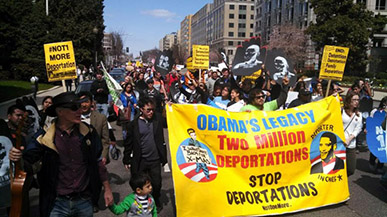
April 5 march in Washington, DC.
The deportation system is about control of a vulnerable labor force. The reasons given as justification for deportations are lies and thinly veiled excuses. It is not, for example, about national safety: less than half of these deportees have ever been convicted of a crime, and the great majority of those who do have criminal records were guilty only of low level crimes: driving without a license, for example, is the most common charge leading to deportation proceedings (and of course undocumented immigrants are not allowed driver’s licenses in most states so this is a “crime” they are forced to commit). Other traffic offenses and minor drug violations are the two largest categories of criminal convictions among deportees.

April 5 sign in Kansas City.
Perhaps most tellingly, 20% of “criminal” deportees are guilty only of the crime of entering the country illegally. Only about 5% of deportees have been convicted of violent crimes. Virtually none of these “criminal deportees” would have faced anything more than a small fine or a short jail stay if they had the rights of U.S. citizens, but because our legal system does not recognize any Constitutional rights for undocumented residents and does not formally consider deportation a “punishment,” immigrants instead have their entire lives turned upside down for minor violations, or more often just for being an immigrant. The real crime here is not living while undocumented, but rather the government’s crime of deporting millions of people.
Nor do economic arguments about deportations hold water. Far from leaching on the U.S. economy, undocumented immigrants on the whole pay considerably more in social security and taxes than they receive back in government benefits, most of which they are ineligible for due to lack of status. The great majority of undocumented people occupy low wage (often sub-minimum wage) jobs with deplorable work conditions which most citizens would not want to begin with.
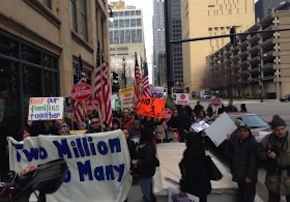
April 7-8 action in Chicago, IL.
The reality is that the political economy of the United States and of global capitalism needs undocumented immigration and acts to ensure that it continues. The presence of undocumented immigrants with almost no legal rights allows certain economic sectors (e.g. agriculture, the service industry, and the building trades) to employ a workforce in the developed Western countries on essentially “third world” terms. Deportation is not intended to rid the country of “illegal immigrants” but rather is a system of managing this population that allows the ruling class to control population levels according to changing needs, as well as to disrupt the ability of immigrants to organize or defend themselves by forcing them to live in fear of removal and by allowing, for example, for ICE raids of workplaces where organizing drives are occurring or expected. The undocumented population, in addition to being the preferred workforce of some employers, is a clear example of the “reserve army of labor” that Marx wrote about.
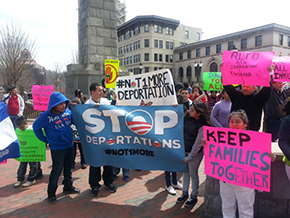
April 5 action in Asheville, NC.
Capitalism is also responsible for most of the root causes of immigration. People migrate primarily for economic reasons, and the economic causes of emigration nearly always originate in damage done by imperialism and capitalism. NAFTA and similar programs, for example, devastated small-scale agriculture in Mexico by subsidizing U.S. imports to Mexico while also ending subsidies and protections for local Mexican farmers; the result was that U.S. corn and poultry now sell in Mexico for prices lower than the local cost of growing corn or raising chickens, and families that have lived off their farms for generations have no choice but to sell their land to large agricultural corporations and seek other sources of work, which very often means immigration to the U.S. or Canada.
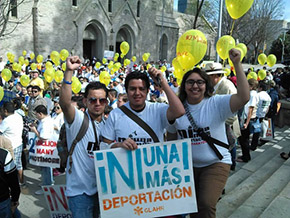
April 5 action in Atlanta, GA.
This was not an “accidental” side effect of free trade agreements but is a harmonious part of a larger system. U.S. corporations profit off of the trade agreements with weaker partners like Mexico, and dump their products there, while simultaneously benefitting from the cheap and easily exploited immigrant work force produced by the same agreements. In fact it is sometimes the same U.S.-based corporations that displace Latin American farmers with new factory farms in Latin American countries, and then hire the displaced farmers to work in U.S. agriculture once they migrate. Some of them even send hiring agents to their Latin American locations to make immigrant work contracts with literally the same farmers they are displacing.
The fight for immigrant rights is not, then, simply a matter of developing or clarifying “effective policies” around immigration, and abandoning the “failed policies” we have now, as liberal commentators would have you think. There are contradictions in what different sectors of the ruling class want from immigration policy, but on the whole policies are accomplishing what they’re intended to accomplish. This struggle, therefore, directly challenges a key component of neoliberalism. This means that resistance from the state will be fierce, but it also means this struggle should be understood to be at the center of resistance to capitalism and imperialism.
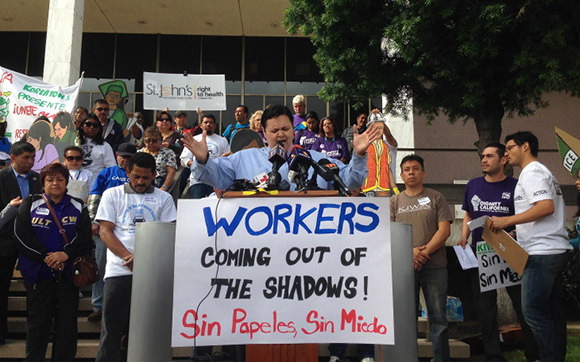
April 5 action in Los Angeles, CA.
Fortunately, there is a militant immigrant movement that is fighting and has already made remarkable strides. The undocumented movement that took off in the mid-2000s around the DREAM Act and immigration reform efforts has radicalized and developed militant tactics and demands. It has moved away from near-futile attempts to pressure Congress for reform and targeted the Obama administration and ICE directly.
Undocumented activists staged sit ins at Obama campaign offices and won the DACA (deferred action) program to grant temporary status and deportation relief to hundreds of thousands of undocumented youth. Innovative border-crossing actions–the Dream 9, the Dream 30, and most recently the Reform 150–challenged the very idea of the border and its militarized management. Activists have taken direct action to shut down deportation buses and immigration detention centers in Phoenix, in Los Angeles, in Atlanta and Chicago, in Alabama, and in other cities around the country.
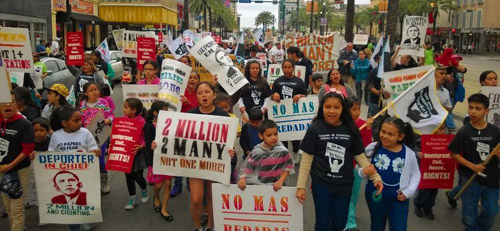
April 5 action in New Orleans, LA.
This movement against deportations gained momentum while most of the immigrant rights movement was still absorbed in the most recent campaign for “comprehensive immigration reform” (CIR). Typically, CIR proposals have been attempts to put a pro-immigrant face on what is really a manifestation of the ruling class agenda (as complicated and contradictory as that agenda is). In practice, the bills in Congress have served to distract and divide the movement without ever putting anything substantial into law, and meanwhile the executive branch of the government implements in practice the major aspects of the legislation (that is, the worst aspects). The anti-deportation movement has bypassed this dynamic by targeting the executive branch directly, demanding a moratorium on deportations and an extension of deferred action to adults, and has made far more progress than the mainstream of the movement as a result.

April 5 action in San Francisco, CA.
More recently, as it has become clear even to the most tactically conservative forces in the movement that CIR is going nowhere and as the more radical wing of the movement has shown that direct action against deportations can be more effective than lobbying, mainstream immigrant rights organizations and NGOs have begun to support the direct demands against deportations, without necessarily dropping the idea that fighting for Congressional reform is the long term goal (as one organizer put it, “they’re saying we have to move to Plan B of targeting Obama, but we always thought that was Plan A”). This shift in strategy happened almost overnight and was clearly the result of some kind of top down decision; whether these groups are legitimately learning from their mistakes, or whether there is something more complicated going on behind closed doors, is unclear, but either way there is currently an opening to popularize the campaign against deportations and to spread consciousness about the role of the Obama administration and the real power dynamics at play.
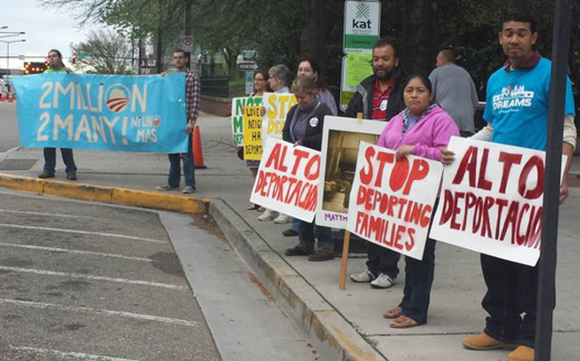
A 24-hour vigil, April 4-5, in Knoxville, TN. Photo by Maggie Jones, Knox News Sentinel.
The April 5th Day of Action Against Deportations was a strong step in this direction. With actions in more than 70 cities, this was the largest and broadest protest against the administration’s deportation practices to date. Obama is clearly feeling some pressure. In March, he met personally with representatives of immigrant rights groups in an attempt to relieve some of that pressure and redirect criticism away from his administration and toward Congress. He has also asked DHS to revisit deportation policies and look for ways to make them “more humane within the confines of the law.”
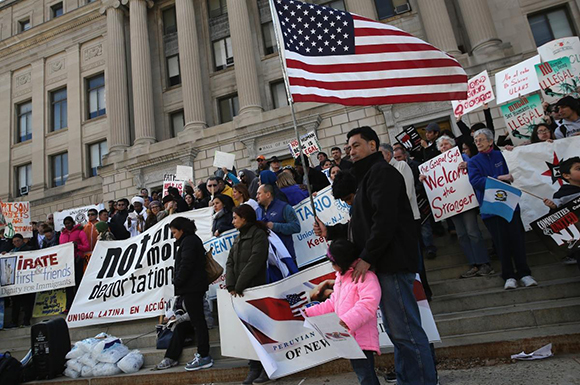
April 5 action in Eloy, AZ.
These are potentially empty promises, of course, and will likely result in no real change without continuing (and escalating) pressure from the movement. But the pieces are in place for that to happen, and some kind of moratorium on deportations during Obama’s second term is not out of the question. As part of the April 5th events, the Not1More campaign announced that activists will maintain a constant presence at the White House until Obama stops deportations. There will be further actions on May Day and after, and the movement is positioned to grow larger and stronger. This is one of the most important social movements in the U.S. today, and we ought to do everything we can to get on board and support the struggle.
Alex is a member of Solidarity in Knoxville, TN.
